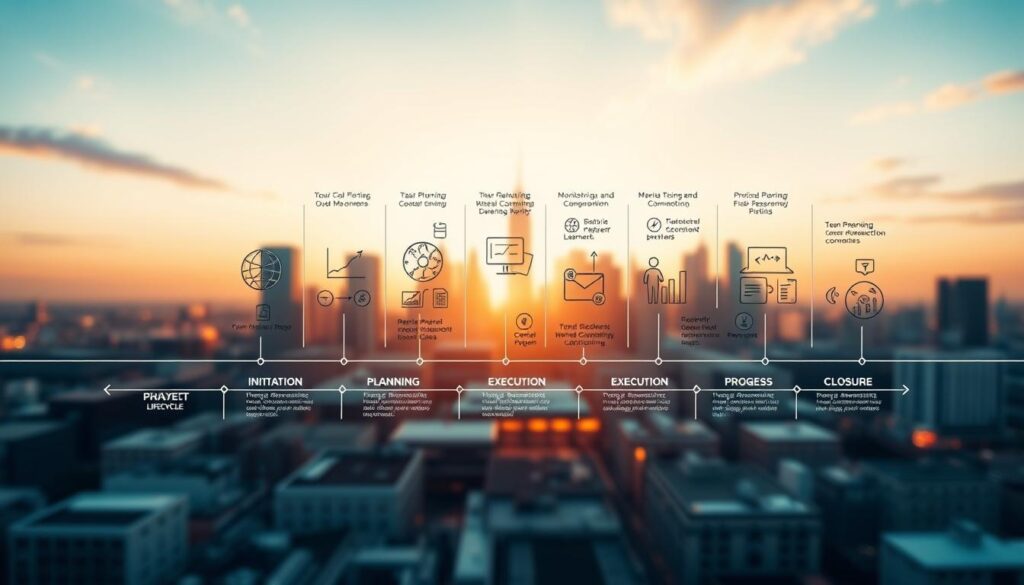In today’s fast-paced business environment, effective project management is crucial for achieving success. With multiple tasks, deadlines, and stakeholders to juggle, project managers need a comprehensive guide to navigate the complexities of their role.
As the business landscape continues to evolve, the importance of project management skills cannot be overstated. By mastering these skills, professionals can drive projects forward efficiently, meet deadlines, and deliver results that meet expectations.
Key Takeaways
- Understand the fundamentals of project management
- Learn how to apply project management skills in real-world scenarios
- Discover strategies for effective project planning and execution
- Explore techniques for managing project teams and stakeholders
- Gain insights into measuring project success
Understanding Project Management: Key Concepts
Project management is a multifaceted discipline that has become indispensable in today’s fast-paced business world. It involves the application of knowledge, skills, and techniques to execute projects effectively, meeting the required objectives and delivering value to stakeholders.
Definition of Project Management
Project management is defined as the process of planning, organizing, and controlling resources to achieve specific goals. It encompasses a broad range of activities, including defining project scope, scheduling, budgeting, and resource allocation. Effective project management ensures that projects are completed on time, within budget, and to the satisfaction of all stakeholders.
The Project Management Institute (PMI) defines project management as “the application of knowledge, skills, tools, and techniques to project activities to meet the project requirements.” This definition highlights the importance of a structured approach to managing projects.
Importance in Today’s Business Environment
In today’s competitive business environment, project management plays a crucial role in driving organizational success. It enables businesses to respond to changing market conditions, innovate, and stay ahead of the competition. Effective project management helps organizations to:
- Deliver projects that meet customer needs and expectations
- Reduce project risks and improve quality
- Enhance collaboration and communication among team members
- Improve resource utilization and reduce waste
According to recent studies, organizations that adopt robust project management practices tend to have higher project success rates and better overall performance.
Types of Project Management Methodologies
There are various project management methodologies that organizations can adopt, depending on their specific needs and project requirements. Some of the most popular methodologies include:
- Agile Methodology: Emphasizes flexibility, collaboration, and rapid delivery. It is particularly suited for projects with changing requirements.
- Waterfall Methodology: A linear approach that follows a sequential process. It is suitable for projects with well-defined requirements and a fixed timeline.
- Hybrid Methodology: Combines elements of different methodologies to create a tailored approach that suits the project’s needs.
Understanding these methodologies is crucial for project managers to choose the most appropriate approach for their projects, ensuring successful project outcomes.
The Project Lifecycle: Phases Explained

The project lifecycle, comprising initiation, planning, execution, and closure, is essential for delivering successful projects. Understanding these phases is crucial for project managers to effectively manage resources, timelines, and stakeholder expectations.
Initiation Phase
The initiation phase is where the project’s foundation is laid. It involves defining the project’s objectives, scope, and stakeholders. Key activities include developing the project charter and conducting a feasibility study. Project management software can be utilized to document and share project information with stakeholders.
Planning Phase
During the planning phase, the project manager develops a detailed project plan, including timelines, budgets, and resource allocation. This phase involves creating a work breakdown structure (WBS), scheduling tasks, and identifying potential risks. Effective project planning is critical for project success, and project management tools can facilitate this process.
Execution Phase
The execution phase is where the project plan is put into action. The project team carries out the tasks outlined in the plan, and the project manager monitors progress. This phase requires effective communication and coordination among team members, which can be supported by project management software.
Closure Phase
The closure phase involves completing any remaining tasks, documenting lessons learned, and evaluating project success. It’s an opportunity to reflect on what went well and what didn’t, providing valuable insights for future projects. Project management tools can help in tracking project completion and documenting final reports.
| Phase | Key Activities | Tools/Software |
|---|---|---|
| Initiation | Define project objectives, scope, and stakeholders | Project charter documentation |
| Planning | Develop project plan, timelines, and budgets | Gantt charts, scheduling software |
| Execution | Carry out tasks, monitor progress | Task management, collaboration tools |
| Closure | Complete tasks, document lessons learned | Project reporting, documentation tools |
Essential Skills for Project Managers
The role of a project manager is multifaceted, demanding a blend of technical, managerial, and leadership skills. Effective project managers must be able to adapt to different project management methodologies, such as Agile project management, to deliver projects successfully.
Communication Skills
Good communication is the backbone of any successful project. Project managers must be able to clearly articulate project goals, objectives, and timelines to team members and stakeholders. This involves not only conveying information but also listening actively and responding to concerns.
Effective communication skills include:
- Clear and concise messaging
- Active listening
- Conflict resolution
- Stakeholder management
Leadership Qualities
Strong leadership is critical to project success. Project managers must be able to motivate and inspire team members to achieve their best work. This involves setting a clear vision, empowering team members, and leading by example.
Problem-Solving Techniques
Project managers must be able to analyze problems, identify solutions, and implement corrective actions. This involves using tools and techniques such as root cause analysis, SWOT analysis, and decision trees.
| Problem-Solving Technique | Description | Application |
|---|---|---|
| Root Cause Analysis | Identifying the underlying cause of a problem | Corrective actions |
| SWOT Analysis | Analyzing strengths, weaknesses, opportunities, and threats | Strategic planning |
| Decision Trees | Visualizing decisions and their potential outcomes | Risk management |
In conclusion, project managers require a range of project management skills to deliver projects successfully. By developing strong communication, leadership, and problem-solving skills, project managers can navigate complex projects and achieve their goals.
Tools and Software for Effective Project Management

The use of project management software has become an essential aspect of modern project management, enabling teams to collaborate more effectively and manage projects efficiently. With numerous options available, it’s crucial to understand the different types of tools and software, their features, and how to integrate them into your project workflow.
Popular Project Management Tools
Several project management tools have gained popularity due to their comprehensive features and user-friendly interfaces. Some of these include:
- Trello: Known for its Kanban board approach, Trello is ideal for visualizing tasks and tracking progress.
- Asana: Asana is a powerful tool for task management, allowing teams to assign tasks, set deadlines, and track work.
- Microsoft Project: A robust project management tool that offers advanced scheduling and resource allocation features.
For a more detailed look at various project management software options, you can explore resources like Zapier’s guide to free project management, which provides insights into different tools and their capabilities.
Criteria for Selecting the Right Tool
When selecting a project management tool, several factors should be considered:
- Project Size and Complexity: Larger, more complex projects may require more advanced features.
- Team Size and Distribution: Tools that facilitate collaboration are crucial for distributed teams.
- Budget: Cost is a significant factor; some tools offer free versions or trials.
- Specific Needs: Consider the specific needs of your project, such as Gantt charts or time tracking.
Integrating Tools into Workflow
Once a tool is selected, integrating it into your workflow is the next step. This involves:
- Training the Team: Ensuring that all team members are comfortable using the tool.
- Customizing the Tool: Tailoring the tool to fit your project’s specific needs.
- Monitoring and Adjusting: Continuously monitoring the tool’s effectiveness and making adjustments as necessary.
By carefully selecting and integrating project management tools and software, teams can significantly enhance their productivity and project outcomes.
Setting Clear Project Goals and Objectives
Clear project goals and objectives are the cornerstone of effective project management. By establishing well-defined goals, project managers can ensure that their team is working towards a common objective, enhancing collaboration and productivity.
SMART Criteria for Goal Setting
One of the most effective project management techniques for setting project goals is the SMART criteria. SMART stands for Specific, Measurable, Achievable, Relevant, and Time-bound. By applying these criteria, project managers can create clear and actionable goals. For instance, instead of setting a vague goal like “improve project efficiency,” a SMART goal would be “reduce project delivery time by 15% within the next 6 months.”
Utilizing SMART criteria helps in avoiding ambiguity and ensures that the project team is focused on tangible objectives. According to various studies, projects that use SMART goals have a higher success rate compared to those that do not.
Aligning Goals with Organizational Vision
It’s crucial that project goals are aligned with the overall organizational vision. This alignment ensures that the project contributes to the broader objectives of the organization. For example, if an organization’s vision is to be a leader in sustainable practices, project goals should reflect this by incorporating sustainability metrics. More information on aligning project goals with organizational objectives can be found in resources such as engineering project management objectives.
Communicating Goals to the Team
Once project goals are established, it’s essential to communicate them effectively to the project team. Clear communication ensures that everyone understands their roles and responsibilities in achieving the project objectives. Project managers should use various project management methodologies to facilitate this communication, such as regular team meetings, project management software, and detailed project plans.
Effective communication of project goals not only motivates the team but also helps in identifying potential issues early on, allowing for timely interventions. By fostering an environment where team members are aware of and committed to the project goals, project managers can significantly enhance the likelihood of project success.
Stakeholder Engagement: Building Relationships

Engaging stakeholders is fundamental to achieving project objectives and ensuring long-term success. Effective stakeholder management is a critical project management skill that can make or break a project.
Identifying Stakeholders
The first step in stakeholder engagement is identifying who the stakeholders are. This includes anyone who can impact or be impacted by the project, such as team members, sponsors, customers, and end-users. For more insights on managing complex projects, visit construction project management resources.
Strategies for Effective Communication
Once stakeholders are identified, developing a communication strategy is crucial. This involves understanding the needs and expectations of each stakeholder group and tailoring the communication approach accordingly. Clear and transparent communication helps in building trust and ensuring that stakeholders are aligned with project goals.
Managing Stakeholder Expectations
Managing stakeholder expectations is an ongoing process that requires continuous engagement and feedback. It’s essential to set realistic expectations from the outset and keep stakeholders informed about project progress. This helps in mitigating potential conflicts and ensuring that stakeholder needs are met.
By focusing on stakeholder engagement and building strong relationships, project managers can significantly enhance the likelihood of project success. It’s a critical aspect of stakeholder management that requires careful planning, effective communication, and a proactive approach to managing expectations.
Developing a Comprehensive Project Plan
To ensure project success, it’s essential to develop a comprehensive project plan that outlines clear goals, objectives, and strategies. A well-crafted project plan serves as a guide for the project team, stakeholders, and sponsors, ensuring everyone is aligned and working towards the same objectives.
Components of a Project Plan
A comprehensive project plan includes several key components. These are:
- Project scope statement
- Work Breakdown Structure (WBS)
- Project schedule
- Budget and resource allocation plan
- Risk management plan
- Quality management plan
Each of these components plays a vital role in ensuring the project is executed efficiently and effectively. Utilizing project management tools and project management software can significantly enhance the planning process.
Creating a Work Breakdown Structure (WBS)
A Work Breakdown Structure (WBS) is a hierarchical decomposition of the project into smaller, manageable tasks. It is a critical component of the project plan, as it allows for the estimation of resources, timelines, and costs.
- Identifying major deliverables
- Breaking down deliverables into smaller tasks
- Assigning tasks to team members
- Establishing a task hierarchy
Risk Management Planning
Risk management is an essential aspect of project planning. It involves identifying potential risks, assessing their likelihood and impact, and developing mitigation strategies. A risk management plan helps to minimize the impact of unforeseen events on the project.
| Component | Description |
|---|---|
| Project Scope Statement | Defines what is included and excluded from the project |
| Work Breakdown Structure (WBS) | A hierarchical decomposition of the project into smaller tasks |
| Project Schedule | Timeline for completing project tasks and milestones |
| Budget and Resource Allocation Plan | Details the financial and human resources required for the project |
| Risk Management Plan | Identifies potential risks and outlines mitigation strategies |
Time Management: Keeping Projects on Track

The ability to manage time efficiently is crucial for keeping projects on track. Effective time management enables project managers to allocate resources appropriately, set realistic deadlines, and monitor progress towards project goals.
Gantt Charts and Timelines
Gantt charts and timelines are essential tools in project time management. They provide a visual representation of the project schedule, helping teams understand the sequence of tasks and their duration.
Gantt charts are particularly useful for illustrating the dependencies between tasks and the critical path of a project. By using Gantt charts, project managers can identify potential bottlenecks and develop strategies to mitigate them.
Prioritizing Tasks Effectively
Prioritizing tasks is a critical aspect of time management in project management. It involves identifying the most important tasks that need to be completed to meet project objectives.
- Identify critical tasks that determine the project timeline.
- Focus on high-priority tasks first.
- Allocate resources based on task priority.
Techniques for Tracking Progress
Tracking project progress is vital to ensure that the project is on track to meet its objectives. Several techniques can be employed, including:
| Technique | Description | Benefits |
|---|---|---|
| Regular Status Meetings | Meetings held regularly to update on task status. | Enhances team communication, identifies issues early. |
| Progress Reporting | Regular reports on task completion and issues. | Provides stakeholders with timely updates, helps in issue resolution. |
| Earned Value Management (EVM) | A method to measure project performance. | Integrates project scope, schedule, and resource measurements. |
By implementing these time management strategies, project managers can better control their projects, ensuring they are completed on time, within budget, and to the required quality standards.
Budgeting for Projects: Financial Management
A well-managed budget is the backbone of any successful project, enabling project managers to make informed decisions. Effective financial management is crucial for project success, as it ensures that resources are allocated efficiently and that the project is delivered within the allocated budget.
Estimating Costs Accurately
Accurate cost estimation is a critical component of project budgeting. It involves identifying all the costs associated with the project, including labor, materials, and overheads. Project managers can use various techniques, such as bottom-up estimating or analogous estimating, to arrive at a realistic cost estimate. Project management certification programs often emphasize the importance of accurate cost estimation in project planning.
Budget Monitoring Best Practices
Once the budget is established, it’s essential to monitor expenses regularly to ensure that the project stays on track financially. This involves tracking actual costs against the budget and taking corrective action when necessary. Effective budget monitoring enables project managers to identify potential financial risks early and make adjustments to mitigate them. Developing project management skills such as financial management is vital for project managers to oversee budgeting effectively.
Handling Financial Risks
Financial risks can arise from various sources, including changes in market conditions, unforeseen expenses, or inaccurate cost estimates. To manage these risks, project managers need to identify potential financial risks early and develop strategies to mitigate them. This might involve allocating a contingency fund or developing alternative plans to address potential financial issues. By proactively managing financial risks, project managers can ensure that their projects are delivered within budget and to the required quality standards.
Team Dynamics: Fostering Collaboration

Project management is not just about managing tasks; it’s also about fostering a collaborative team environment. Effective team management is crucial for the success of any project, as it directly impacts how well team members work together to achieve common goals.
Building a High-Performing Team
Building a high-performing team requires a deep understanding of project management skills, including the ability to motivate team members, manage conflicts, and facilitate effective communication. According to resources on team dynamics, a well-structured team can significantly enhance project outcomes.
To build such a team, project managers must first identify the strengths and weaknesses of their team members. This involves creating an environment where everyone feels valued and encouraged to contribute. For more insights on effective team collaboration, especially in engineering projects, visit effective team collaboration practices.
Conflict Resolution Strategies
Conflicts are inevitable in any team setting. However, it’s how these conflicts are managed that can make or break a project’s success. Effective conflict resolution strategies include open communication, active listening, and a fair approach to resolving disputes.
By addressing conflicts promptly and fairly, project managers can prevent them from escalating into major issues that could derail the project. This not only improves team morale but also ensures that the team remains focused on the project’s objectives.
Enhancing Team Communication
Effective communication is the backbone of any successful team. It involves not just conveying information but also ensuring that the message is understood and acted upon. Project managers can enhance team communication by using clear and concise language, leveraging technology to facilitate communication, and encouraging feedback.
Regular team meetings, updates, and the use of collaborative tools can significantly improve how team members interact and work together. By fostering an environment of open and transparent communication, project managers can ensure that their team is aligned and working towards the same goals.
Evaluating Project Progress and Performance
Effective project management requires ongoing evaluation of progress and performance. This involves using various project management techniques to track progress, identify areas for improvement, and make informed decisions.
Key Performance Indicators (KPIs)
Key Performance Indicators (KPIs) are quantifiable measures used to evaluate the success of a project. They help project managers assess progress toward goals and objectives. Common KPIs include:
- Project schedule performance
- Budget variance
- Resource utilization
- Quality metrics
To effectively use KPIs, project managers should establish clear targets and thresholds. For example, a project might aim to complete within 10% of the scheduled timeline. Regular tracking against these KPIs enables timely interventions when deviations occur.
Regular Reporting Practices
Regular reporting is crucial for maintaining transparency and ensuring stakeholders are informed. Reports should be concise, focusing on key information such as progress against KPIs, upcoming milestones, and potential risks. The frequency of reporting depends on the project’s complexity and stakeholder needs.
| Reporting Frequency | Typical Use Cases | Benefits |
|---|---|---|
| Daily | High-intensity projects, critical phases | Immediate issue identification, rapid decision-making |
| Weekly | Standard project monitoring | Balanced detail and brevity, regular stakeholder updates |
| Monthly | Long-term projects, strategic reviews | High-level overview, trend analysis |
Utilizing Feedback for Improvement
Feedback is a vital component of project evaluation, allowing project managers to identify strengths and weaknesses. Feedback can be gathered from team members, stakeholders, and end-users through surveys, interviews, and retrospectives.
To utilize feedback effectively, project managers should:
- Analyze feedback to identify patterns and areas for improvement
- Develop action plans to address identified issues
- Implement changes and monitor their impact
By integrating feedback into the project management process, teams can adapt and improve their project management methodologies, enhancing overall project success.
Adapting to Change: Flexibility in Project Management

The ability to adapt to change is a critical factor in determining the success or failure of a project. In an environment where requirements and circumstances can shift rapidly, project managers must be prepared to adjust their plans accordingly.
According to recent studies, adapting to change is critical for project success. This involves not just reacting to changes but also anticipating and planning for them. Effective change management is at the heart of this adaptability.
The Role of Change Management
Change management is a systematic approach to dealing with change, both from the perspective of an organization and on the individual level. In project management, it involves identifying potential changes, assessing their impact, and implementing them in a controlled manner.
Key aspects of change management include:
- Identifying the need for change
- Assessing the impact of the change
- Developing a plan to implement the change
- Communicating the change to stakeholders
- Monitoring and controlling the change
For more insights on adapting to change in project management, visit this resource for a deeper dive into the importance of flexibility.
Strategies for Agile Adaptation
Agile project management methodologies are designed to accommodate change and uncertainty. By using iterative development cycles, continuous feedback, and flexible planning, Agile enables teams to respond quickly to changing requirements.
| Agile Principle | Description | Benefit |
|---|---|---|
| Iterative Development | Breaking down work into smaller, manageable chunks | Allows for flexibility and adaptation |
| Continuous Feedback | Regularly reviewing progress and incorporating feedback | Ensures the project is on track and meets stakeholder needs |
| Flexible Planning | Adapting plans based on changing requirements | Enables the team to respond to change quickly |
Lessons Learned Documentation
Documenting lessons learned is an essential part of project closure and continuous improvement. It involves capturing the knowledge and experience gained during the project to inform future projects.
Best practices for documenting lessons learned include:
- Conducting regular retrospectives
- Capturing both successes and failures
- Analyzing the root causes of issues
- Sharing the lessons learned across the organization
Post-Project Evaluation: Learning from Experience
Learning from project experiences is key to enhancing project management practices and achieving continuous improvement. By thoroughly evaluating the outcomes of completed projects, project managers can refine their skills, address weaknesses, and build on strengths.
Conducting a Project Review
A comprehensive project review is the foundation of post-project evaluation. It involves gathering the project team and stakeholders to discuss the project’s progression, challenges faced, and outcomes achieved. This collaborative review process helps in identifying what worked well and what didn’t, providing a clear picture of the project’s overall performance.
During the review, it’s essential to document all feedback and observations. This can be done through meeting minutes, surveys, or project review reports. The information collected will serve as the basis for further analysis and decision-making.
Analyzing Successes and Failures
Analyzing both successes and failures is crucial for a balanced understanding of the project’s performance. Successes highlight effective strategies and practices that contributed to the project’s achievements. Conversely, failures or areas for improvement reveal opportunities for growth and development in project management skills.
By examining the root causes of any issues that arose during the project, project managers can develop strategies to mitigate similar risks in future projects. This analysis also helps in recognizing patterns or recurring themes that may inform future project planning and execution.
Implementing Continuous Improvement
The ultimate goal of post-project evaluation is to implement continuous improvement in project management practices. By applying the insights gained from the project review and analysis, project managers can refine their approaches, update their toolsets, and enhance their skills.
Continuous improvement involves not just addressing the immediate lessons learned but also fostering a culture that values ongoing learning and adaptation. This can be achieved through regular training, workshops, and the adoption of new methodologies or technologies that support project management excellence.
By embracing post-project evaluation and continuous improvement, organizations can ensure that their project management practices remain dynamic, effective, and aligned with their strategic objectives.
Certification and Professional Development in Project Management

To remain competitive, project managers must invest in their professional growth. Certification and professional development are critical components of a successful career in project management. According to recent studies, certified project managers are more likely to deliver projects on time, within budget, and to the required quality standards.
Popular Project Management Certifications
Several certifications are highly regarded in the project management industry. These include the Project Management Professional (PMP) certification, offered by the Project Management Institute (PMI), and the Agile Certified Practitioner (ACP) certification, also from PMI. Other notable certifications include the Scrum Master Certification (SMC) and the PRINCE2 certification. These certifications demonstrate a project manager’s expertise and commitment to their profession.
Benefits of Certification
Obtaining a project management certification can have numerous benefits. It not only enhances a project manager’s skills and knowledge but also boosts their credibility and career prospects. Certified project managers are often preferred by employers, and certification can lead to higher salary potential. For instance, a project manager with a PMP certification can access a range of benefits, including project management resources and networking opportunities.
Opportunities for Continued Learning
The field of project management is constantly evolving, with new methodologies, tools, and technologies emerging regularly. To stay current, project managers must pursue ongoing education and training. This can involve participating in project management courses, attending workshops and conferences, and engaging with professional associations. By doing so, project managers can continue to develop their skills and adapt to the changing landscape of their profession.
Future Trends in Project Management
The project management landscape is evolving rapidly, driven by technological innovations and changing workforce dynamics. As organizations strive to stay competitive, it’s essential to understand the emerging trends that will shape the future of project management.
Emerging Technologies
Technologies like artificial intelligence (AI) and automation are transforming project management by analyzing data, predicting outcomes, and automating routine tasks. For more insights on leveraging technology in project management, visit World Civil Society. Effective project managers will need to develop skills that complement these technologies, enhancing their project management skills.
Remote Project Management
The rise of remote work has accelerated the adoption of cloud-based solutions and virtual collaboration tools. Project managers must be adept at managing remote teams, fostering collaboration, and ensuring project success despite geographical distances.
Sustainable Practices
Sustainability is becoming a critical aspect of project management, with organizations increasingly focusing on environmentally friendly and socially responsible practices. Project managers will need to integrate sustainability into their project management methodologies, ensuring that projects are not only successful but also sustainable.
By staying informed about these trends and adapting to the changing landscape, project managers can ensure their skills remain relevant and their projects continue to deliver value in a rapidly evolving world.
